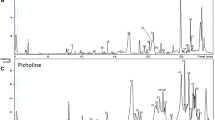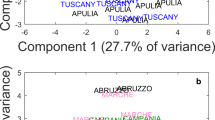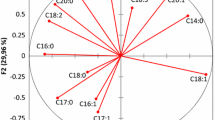Abstract
A study on the characterization of Tunisian extra-virgin olive oil varieties produced in their place of origin has been carried out. Due to the influence of the genotype and environmental, agronomic and technological factors on the chemical composition of olive oil and its quality, all the olives studied were collected on the same season, and the oil was obtained under the same processing technique. Several analyses were performed to characterize the different olive oils: free acidity, peroxide value, fatty acid composition, radical scavenging activity, Rancimat assay, pigments content and phenolic compounds by HPLC–MS. In order to evaluate all the results obtained (36 parameters for each variety), different statistical analyses were used to discriminate the extra-virgin olive oil varieties: one-way analysis of variance was performed to check significant differences among cultivars (p ≤ 0.05); PCA was applied to the data showing that variables such as oleic, linoleic, quinic and vanillic acids, apigenin, luteolin, taxifolin, oleuropein aglycon, pinoresinol acetate, elenolic acid and oxidative stability allowed discriminating among the different varieties of extra-virgin olive oil studied. Besides, LDA model was able to classify the samples depending on their geographical origin in Tunisia (North, Centre and South).



Similar content being viewed by others
References
Haddada FM, Manai H, Oueslati I, Daoud D, Sánchez J, Osario E, Zarrouk M (2007) Fatty acid, triacylglycerol, and phytosterol composition in six Tunisian olive varieties. J Agric Food Chem 55:10941–10946
Aparicio R, Luna G (2002) Characterisation of monovarietal virgin olive oils. Eur J Lipid Sci Technol 104(9–10):614–627
Tura D, Gigliotti C, Pedo S, Failla O, Bassi D, Serraiocco A (2007) Influence of cultivar and site of cultivation on levels of lipophilic and hydrophilic antioxidants in virgin olive oils (Olea Europea L.) and correlations with oxidative stability. Sci Hortic 112:108–119
Gómez-Caravaca AM, Cerretani L, Bendini A, Segura-Carretero A, Fernández-Gutiérrez A, Del Carlo M, Compagnone D, Cichelli A (2008) Effect of fly attack (Bactrocera oleae) on phenolic profile and selected chemical parameters of olive oil. J Agric Food Chem 56:4577–4583
Martínez de Victoria E, Mañas M (2001) In: Barranco D, Fernández-Escobar R, Rallo L (eds) El cultivo del olivo. MundiPrensa, Madrid
Visioli F, Galli C (1994) Oleuropein protects low density lipoproteins from oxidation. Life Sci 55:1965–1971
Visioli F, Galli C (1998) The effect of minor constituents of olive oil on cardiovascular disease: New findings. Nutr Rev 56:142–147
Ben Temine S, Abaza L, Ben Youssef N, Taamalli W, Msallem M, Daoud D, Zarrouk M (2004) Chemical and thermal characterization of Tunisian extra virgin olive oil from Chetoui and Chemlali cultivars and different geographical origin. Riv Ital Sostanze Grasse 81:277–283
Guerfel M, Ouni Y, Taamalli A, Boujnah D, Stefanoudaki E, Zarrouk M (2009) Effect of location on virgin olive oils of the two main Tunisian olive cultivars. Eur J Lipid Sci Technol 111:926–932
Guerfel M, Baccouri O, Boujnah D, Chaibi W, Zarrouk M (2009) Impacts of water stress on gas exchange, water relations, chlorophyll content and leaf structure in the two main Tunisian olive (Olea europaea L.) cultivars. Sci Hortic 119:257–263
Kotti F, Chiavaro E, Cerretani L, Barnaba C, Gargouri M, Bendini A (2009) Chemical and thermal characterization of Tunisian extra virgin olive oil from Chetoui and Chemlali cultivars and different geographical origin. Eur Food Res Technol 228:735–742
Baccouri O, Cerretani L, Bendini A, Caboni MF, Zarrouk M, Pirrone L, Daoud D (2007) Preliminary chemical characterization of Tunisian monovarietal virgin olive oils and comparison with Sicilian ones. Eur J Lipid Sci Technol 109:1208–1217
Dabbou S, Issaoui M, Servili M, Taticchi A, Sifi S, Montedoro GF, Hammami M (2009) Characterisation of virgin olive oils from European olive cultivars introduced in Tunisia. Eur J Lipid Sci Technol 111:392–401
Dabbou S, Issaoui M, Esposto S, Sifi S, Taticchi A, Servili M, Montedoro GF, Hammami M (2009) Cultivar and growing area effects on minor compounds of olive oil from autochthonous and European introduced cultivars in Tunisia. J Sci Food Agric 89:1314–1325
Uceda M, Hermoso M (1998) La calidad del aceite de oliva. In: Barranco D, Fernandez-Escobar R, Rallo L (eds) El Cultivo del Olivo. Junta de Andalucıa Ediciones Mundi-Prensa, Madrid (Spain), pp 547–572
Donaire JP, Sanchez-Raya AJ, Lopez-George JL, Recalde L (1977) Etudes physiologiques et biochimiques de l’olive: I. Variations de la concentration de divers metabolites pendant son cycle evolutif. Agrochimica 21:311–321
European Union Commission Regulation 2568/91 (1991) Characteristics of olive and olive pomace oils and their analytical methods. Off J Eur Commun L248:1–82
European Union Commission Regulation (EC) No 2527/95 of 27 October 1995 amending Regulation (EEC) No 2568/91 on the characteristics of olive oil and olive-residue oil and on the relevant methods of analysis. Off J Eur Commun L248
European Union Commission Regulation 2568/1.7.91 (1991) On the characteristics of olive oils and kernel olive oils and on their methods of analysis. Off J Eur Commun L248
Kalantzakis G, Blekas G, Pegklidou K, Boskou D (2006) Stability and radical-scavenging activity of heated olive oil and other vegetable oils. Eur J Lipid Sci Technol 108:329–335
Gutiérrez F (1989) Determinacion de la estabilidade oxidativa de aceites de oliva virgenes: comparacion entre del método A.O.M. y el método Rancimat. Grasas y Aceites 40:1–5
Minguez-Mosquera MI, Rejano L, Gandul B, Sanchez AH, Garrido J (1991) Color-pigment correlation in virgin olive oil. J Am Oil Chem Soc 68:332–336
Tsimidou M (1998) Polyphenols and quality of virgin olive oil in retrospect. Ital J Food Sci 10:99–116
García-Villalba R, Carrasco-Pancorbo A, Oliveras-Ferraros C, Vázquez-Martín A, Menéndez JA, Segura-Carretero A, Fernández-Gutiérrez A (2010) Characterization and quantification of phenolic compounds of extra-virgin olive oils with anticancer properties by a rapid and resolutive LC-ESI-TOF MS method. J Pharm Biomed Anal 51:416–429
Tous J, Romero A (1993) Variedades de olivo. Con especial referencia a Cataluña. Fundación “La Caixa”, Barcelona
Cerretani L, Bendini A, Rotondi A, Lercker G, Gallina-Toschi T (2005) Analytical comparison of monovarietal virgin olive oils obtained by both a continuous industrial plant and a low-scale mill. Eur J Lipid Sci Technol 107(2):93–100
Inarejos-García AM, Gómez-Rico A, Salvador MD, Fregapane G (2009) Influence of malaxation conditions on virgin olive oil yield, overall quality and composition. Eur Food Res Technol 228:671–677
Cerretani L, Bendini A, Del Caro A, Piga A, Vacca V, Caboni MF, Gallina-Toschi T (2006) Preliminary characterisation of virgin olive oils obtained from different cultivars in Sardinia. Eur Food Res Technol 222:354–361
Rotondi A, Bendini A, Cerretani L, Mari M, Lercker G, Gallina-Toschi T (2004) Effect of olive ripening degree on the oxidative stability and organoleptic properties of Cv. Nostrana di Brisighella extra virgin olive oil. J Agric Food Chem 52:3649–3654
Haddada FM, Manai H, Daoud D, Fernandez X, Lizzani-Cuvelier L, Zarrouk M (2007) Profiles of volatiles compounds from some monovarietal Tunisian virgin olive oils. Comparison with French PDO. Food Chem 103:467–476
Zarrouk W, Baccouri B, Taamalli W, Trigui A, Daoud D, Zarrouk M (2009) Oil fatty acid composition of eighteen Mediterranean olive varieties cultivated under the arid conditions of Boughrara (southern Tunisia). Grasas y Aceites 60:498–506
Carrasco-Pancorbo A, Neusüß C, Pelzing M, Segura-Carretero A, Fernández-Gutiérrez A (2007) CE- and HPLC-TOF-MS for the characterization of phenolic compounds in olive oil. Electrophoresis 28:806–821
Garcia A, Brenes M, Romero C, Garcia P, Garrido A (2002) Study of phenolic compounds in virgin olive oils of the Picual variety. Eur Food Res Technol 215:407–412
Velasco J, Dobarganes C (2002) Oxidative stability of virgin olive oil. Eur J Lipid Sci Technol 104:661–676
Baccouri O, Guerfel M, Baccouri B, Cerretani L, Bendini A, Lercker G, Zarrouk M, Ben Miled DD (2008) Chemical composition and oxidative stability of Tunisian monovarietal virgin olive oils with regard to fruit ripening. Food Chem 109:743–754
Tovar MJ, Romero MP, Alegre S, Girona J, Motilva MJ (2002) Composition and organoleptic characteristic of oil from Arbequina olive (Olea europaea L.) trees under deficit irrigation. J Sci Food Agric 82:1755–1763
Gulcin I (2006) Antioxidant and antiradical activities of L-carnitine. Life Sci 78:803–811
Samaniego-Sanchez C, Troncoso González AM, Garcıa-Parrilla MC, Quesada Granados JJ, García López, de la Serrán H, López Martínez MC (2007) Different radical scavenging tests in virgin olive oil and their relation to the total phenol content. Anal Chim Acta 593:103–107
Vandeginste BGM, Massart DL, Buydens LMC, De Jong S, Lewi PJ, Smeyers-Verbeke J (1998) Data handling in science and technology–Part B. Elsevier Science BV, Amsterdam
Author information
Authors and Affiliations
Corresponding author
Rights and permissions
About this article
Cite this article
Taamalli, A., Gómez-Caravaca, A.M., Zarrouk, M. et al. Determination of apolar and minor polar compounds and other chemical parameters for the discrimination of six different varieties of Tunisian extra-virgin olive oil cultivated in their traditional growing area. Eur Food Res Technol 231, 965–975 (2010). https://doi.org/10.1007/s00217-010-1350-3
Received:
Revised:
Accepted:
Published:
Issue Date:
DOI: https://doi.org/10.1007/s00217-010-1350-3




